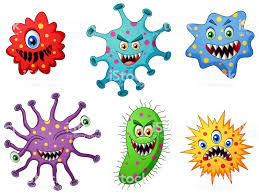Covid-19 & Virus
■ Virus :(what is a virus)
• Virus was discovered by Ivanovsky.
• Tobacco Mosaic Virus was the first virus discovered.
• It can survive only inside another living organism, animal or plant.
• It is a connecting link between living and non-living things.
■ Living properties of Viruses :
• The presence of DNA or RNA (but never both).
• Genetic and parasitic properties.
• Capable of spreading the disease.
■ Non-living properties.
• The absence of cell and lack of protoplasm • No any reproduction and growth outside the living cell • The lack of metabolic activities like nutrition, digestion.
● Structure of Virus:
• Virus has genetic material, either (DNA) Or (RNA).
• Capsid- protein shell of virus and which protect the nucleic acid and aid in its transmission between host cells.
• Some viruses have a third structure that surrounds the capsid called the envelope and is composed of a bilipid layer and glycoproteins.
• Envelope protects the virus from immune system when host secretes anti- virus substances called interferons.
■ What Are Coronavirus ?
• Coronaviruses (CoV) are a large family of viruses that cause illness ranging from the common cold to more severe diseases such as Middle East Respiratory Syndrome (MERSCoV) and Severe Acute Respiratory Syndrome (SARS-CoV).
• They are a group of viruses that cause respiratory diseases in mammals and birds.
• The name "coronavirus" is derived from the Latin corona which means crown.
• Coronaviruses are zoonotic, meaning they are transmitted between animals and people.
• On February 11, 2020 the World Health Organization announced an official name for the disease i.e. coronavirus disease 2019, abbreviated as COVID-19.
• First identified in Wuhan China.
• COVID-19 is a new disease, caused be a novel (or new) coronavirus that has not previously been seen in humans.
• Virus for COVID-19 is SARS COV-2.
■ How is Coronavirus Diagnosed?
• Blood tests
• Throat and nose swabs
■ Who's At Risk?
• Older adults and people with chronic conditions like heart and lung disease
• people who have recently had surgeries for organ or bone marrow transplants, & patients undergoing chemotherapy.
• People with weaker or compromised immune systems.
■ How to reduce risk :------
• Virus was discovered by Ivanovsky.
• Tobacco Mosaic Virus was the first virus discovered.
• It can survive only inside another living organism, animal or plant.
• It is a connecting link between living and non-living things.
■ Living properties of Viruses :
• The presence of DNA or RNA (but never both).
• Genetic and parasitic properties.
• Capable of spreading the disease.
■ Non-living properties.
• The absence of cell and lack of protoplasm • No any reproduction and growth outside the living cell • The lack of metabolic activities like nutrition, digestion.
● Structure of Virus:
• Virus has genetic material, either (DNA) Or (RNA).
• Capsid- protein shell of virus and which protect the nucleic acid and aid in its transmission between host cells.
• Some viruses have a third structure that surrounds the capsid called the envelope and is composed of a bilipid layer and glycoproteins.
• Envelope protects the virus from immune system when host secretes anti- virus substances called interferons.
■ What Are Coronavirus ?
• Coronaviruses (CoV) are a large family of viruses that cause illness ranging from the common cold to more severe diseases such as Middle East Respiratory Syndrome (MERSCoV) and Severe Acute Respiratory Syndrome (SARS-CoV).
• They are a group of viruses that cause respiratory diseases in mammals and birds.
• The name "coronavirus" is derived from the Latin corona which means crown.
• Coronaviruses are zoonotic, meaning they are transmitted between animals and people.
• On February 11, 2020 the World Health Organization announced an official name for the disease i.e. coronavirus disease 2019, abbreviated as COVID-19.
• First identified in Wuhan China.
• COVID-19 is a new disease, caused be a novel (or new) coronavirus that has not previously been seen in humans.
• Virus for COVID-19 is SARS COV-2.
■ How is Coronavirus Diagnosed?
• Blood tests
• Throat and nose swabs
■ Who's At Risk?
• Older adults and people with chronic conditions like heart and lung disease
• people who have recently had surgeries for organ or bone marrow transplants, & patients undergoing chemotherapy.
• People with weaker or compromised immune systems.
■ How to reduce risk :------








Comments
Post a Comment